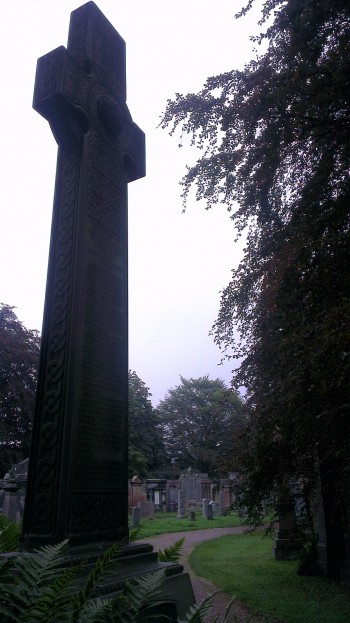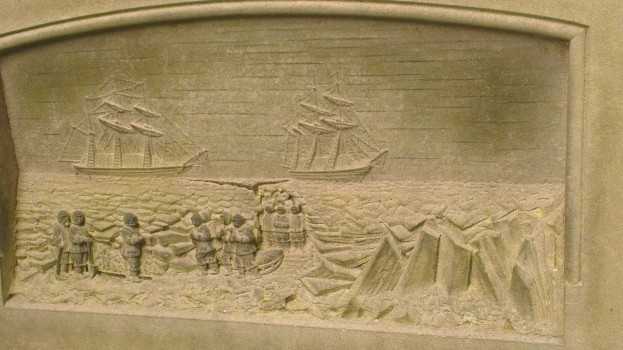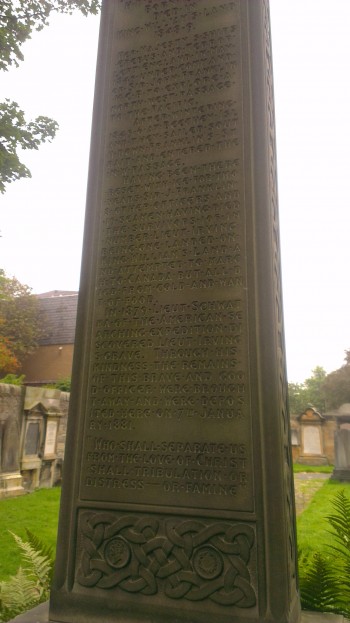Heroism, Cannibalism and the North West Passage
I have written before about The Dean Cemetery, to the rear of The Dean Gallery in Edinburgh. It is an interesting place and many of those that lie peacefully here have a fascinating past, most from Georgian and Victorian society.
Passing through last week – as one of the walks available from www.edinburghwalks.com – I came across the dark Celtic Cross which tells the fascinating story of Lieutenant John Irving of the British Royal Navy.
Irving was part of Sir John Franklin’s expedition to find the North West Passage that left Kent, England in 1845 on board HMS Terror. The other Royal Navy ship in the party was HMS Erebus.
Having wintered at Beechey Island, they thereafter set out to find the Passage, but became locked in the ice for two years. By June 1847 Franklin, twenty Officers and Seamen died, but Irving and 104 other survivors landed on King William Island and tried to march further South into Canada, some 250 miles away. They perished in this venture.
Many expeditions were sent out to trace the crews, and it was in June 1879 that Lieutenant Frederick Schwatka’s American Searching Expedition found Irving’s grave near a place called Camp Crozier, the remains identifiable by the presence of a silver medal engraved ‘Second Mathematical Prize, Royal Naval College. Awarded to John Irving Mid-summer. 1830’, lying nearby. His remains were returned to Edinburgh and on the 7th January 1881 he was buried in the Dean Cemetery.
The tableau on the Cross appears to show the survivors leaving Erebus and Terror to commence their march South.
A synopsis of the terrible affair is also on the cross. However, it brought to mind more recent information that adds colour to this story.
Dr. John Rae was a qualified surgeon from Orkney in Scotland who was employed by the Hudson Bay Company after his arrival there in 1833. He stayed in the Moose Factory area for around 10 years and in this time assimilated with the local native Canadians. He learned their vital survival skills, though his insistence of dressing like a native was frowned upon. Dr. Rae assisted in two searches for Erebus and Terror and their men, but abandoned the search for Franklin in 1854 after learning that the expedition had ended in disaster and that the last survivors having been forced to resort to cannibalism.
In April 1854, Rae had heard from an Inuit that a group of 40 white men had been seen four years previously pulling a boat and sledges South along the West coast of King William Island. From what he was told, Rae decided the men had died in the winter of 1850, after ice had crushed their ships. Some years later, Rae learned that the Inuit had discovered 30 bodies and a number of graves and it appeared the men had died of starvation. But the report of cannibalism caused a scandal which was not accepted by Victorian Britain and, in particular, Franklin’s widow. Even Charles Dickens wrote of his disbelief. But in May 1859 following another expedition, skeletons were found of some of the last survivors and they appeared to confirm that the men had resorted to cannibalism.
Dr. Rae eventually returned to the UK, but his courageous deeds in the snowy wastelands of Northern Canada were never truly recognised….until 2014. On 30th September 2014 a simple plaque was unveiled to Rae in Westminster Abbey in London, England. This plaque is adjacent to a memorial to Franlin.
But there is more……. Also in September 2014 the Canadian Prime Minister Stephen Harper announced the discovery of a ship to the West of King William Island, South of the Victoria Strait. This ship has been confirmed as HMS Terror’s sister ship, HMS Erebus. Work is continuing to find Irving’s ship, which must surely be nearby.
So, although Irving was interred in the Dean Cemetery 133 years ago his story and that of the Franklin Expedition continues to evolve to this day.






